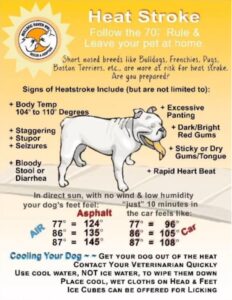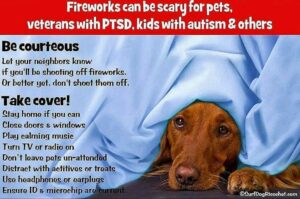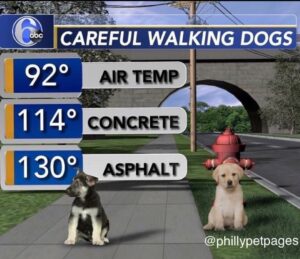Four Seasons of Furry Comfort: Surviving Summer Scorchers!

Whew! It sure has been hot this summer, and we here at Frolic hope you’re all finding ways to stay cool! We’re sure you’ve noticed that it’s not just you who is feeling the heat, as our pets are no more immune to extreme weather than we are. The heat can make for excellent adventures with your furry family members, but it also creates unique challenges and possibly dangerous situations to be aware of and ready to address. But don’t fret! We’re here to provide you with valuable information to help keep your pet happy and healthy in Summer’s extreme weather!
While each season presents unique challenges for our pets, summer’s challenges present the most instantaneous threats to our pets’ well-being. Those 90-to-100 degree days are agonizing for us, so just think about how they must feel when walking around in a fur suit! We’ll go over a few things to keep in mind, and ways to address dangerous situations that may catch you by surprise.
The first summer tip may seem like a no-brainer, but you’d be surprised: never, ever leave your pet alone in a hot, parked car! Cars quickly become death traps for pets—the temperature inside a car can quickly reach 120 degrees Fahrenheit or more on even a mild sunny day. If you just need to run errands, it’s best to leave your pet at home. They may give you the sad eyes when you leave home, but they’ll appreciate it a lot more than heatstroke! In Washington State, they even passed a law (Senate Bill SSB-5501) that states you can’t leave your dog in a car when its too hot OR too cold, so beware!!
Heatstroke is one of the most common and deadly emergencies pets encounter during the summer months, so we want to make sure you do everything you can to avoid it. We’ll go over preventative measures, identifying signs of heatstroke, and what to do if they’re experiencing heatstroke.
First, the two largest contributors to heatstroke are the sun and humidity. Heatstroke doesn’t just occur inside car doors. Days over 90 degrees are dangerous enough on their own, but even more so when paired with the high humidity we often experience here in the pacific northwest. We sweat to get rid of excess heat in humidity, but our pups don’t have that option—dogs only perspire around their foot pads, and otherwise pant to get rid of excess heat.
While panting is generally an efficient way to get rid of heat, high humidity greatly reduces its effectiveness. Further, if you have a pug or other flat-faced breed, they will be more prone to heatstroke because of their smaller nasal passages, which makes circulation of air more difficult. Those of us with chonky doggos should also take extra care, because the extra fat acts as insulation, trapping additional heat inside their bodies, and restricting breathing. Lastly, both young pups whose temperature regulating system hasn’t fully developed, and senior pets whose organs may not function at full capacity anymore are more prone to heatstroke.
 So what does heatstroke look like? There are many symptoms to keep your eye on, including, but not limited to: Excessive panting, aimless staring, fear/anxiety in their expression, not obeying typically-obeyed commands, vomiting, or collapse.
So what does heatstroke look like? There are many symptoms to keep your eye on, including, but not limited to: Excessive panting, aimless staring, fear/anxiety in their expression, not obeying typically-obeyed commands, vomiting, or collapse.
Prevention is of course the best method—if they don’t suffer heatstroke in the first place, you don’t have to worry about giving them medical attention. The simplest ways to prevent heatstroke include making sure they have consistent access to fresh water in a bowl they can’t accidentally knock over, avoiding excessive exercise even if they seem restless, or, potentially, a haircut. Talk with your vet regarding haircuts—some dogs’ coats may seem like they contribute to their heat, but actually work to prevent overheating. A haircut will help some breeds, but can actually be harmful to others’ ability to regulate their body temperature!
If your pet primarily lives outside, make sure they have some sort of shelter or a constant source of shade available to them. As with indoor dogs, they need a large and fresh water source that cannot be tipped over, but if they’re outside it’s important to place the bowl in the shadiest area you can, to ensure they’ll be willing to drink the water.
If you’ve failed to prevent heatstroke, you need to get your pet medical care immediately. While it’s important to act quickly, it’s equally important to remain calm. If you suspect heatstroke, apply towels soaked in cool water to hairless areas of your pet. Call your veterinarian and bring your pet in, even if they seem to respond to the cooling, as sometimes pets react to the cooling and believe they’re ok, only for their temperature to soar back up immediately. Your veterinarian will likely use other cooling techniques, sometimes including an IV, or medication that will prevent or reverse heat-based brain damage. Heatstroke can be fatal even with treatment, so your best bet is prevention.
-Whew-…well, that segment of our extreme weather tips was a bit intense and heavy. We felt it was important to prioritize the most dangerous outcome first, but we’re not trying to get you down! We simply want your pet to be safe during these hot summer months. We’ll lighten the tone for you with some tips and tricks on how to keep your pets comfortable when they’re out adventuring with you!
A lot of us here at Frolic love to take our pups out for hikes, camping trips, or just a relaxing day in the park. Wherever you take them, remember that you need to pack for them, too! We bring food, water, and other comforts for ourselves, and our pets need theirs just as much as we do.
If you’re just taking them out for a walk or a trip to the park, the most important thing to bring with you is a water bottle and a container they can drink from. Parks often have bowls or fountains for dogs to drink from, but it’s best to bring your own if you’re uncertain, of if your dog is like mine, and picky about drinking from bowls other dogs have used. Many of us like to use a portable water bottle designed for pets. You can find many online for relatively cheap, and some come with their own mini-bowl for drinking from, allowing you to cleanly filter water they don’t drink back into the bottle for drinking later. There are many similar products, but you can find one example here: https://www.amazon.com/gp/product/B07T35HCQW/ref=ppx_yo_dt_b_asin_title_o00_s00?ie=UTF8&psc=1
If you’re taking a longer trip, it’s important to make sure you are prepared for unexpected emergencies. The last thing you want is for your pet to suffer an injury miles away from civilization at a campsite or hiking trail with no way to give them the medical attention they need. A standard first-aid kit with bandages, wraps, pads, scissors, tweezers, rubbing alcohol, etc., will make sure you’re prepared in the event of an unexpected injury.
Of course, even if there are no accidents, you dog will need their own suitcase for a long walk or camping trip! Many of our dogs are very food-motivated, so you’ll want to make sure they have plenty of kibble—be sure to store it waterproof & airtight containers so it stays fresh, and doesn’t attract other critters. For long walks or trips to the park, it’s also a good idea to have some treats with you. Once their long day of exertion is over, you may need to dry them off with a towel, and they’d be quite thankful for a nice blanket or bed to lay on, preferably with a bone or one of their favorite toys to chew on. A portable fan and/or spray bottle to help keep them cool is something they’ll also appreciate!
It’s not just the heat that can be a problem, of course—pests are a summer issue, too. We’ve dealt with ants invading pet food bowls on more than one occasion in our work in the field, and there’s a nice, simple way to prevent it—moats! That’s right, a simple medieval castle defense can be enough to make sure your pet’s food isn’t attacked by those six-legged troublemakers. Simply place your pet’s food bowl in a larger bowl or slightly-sloped plate filled with water, and the ants will turn right around. Turns out ants aren’t the best swimmers, and they aren’t willing to figure it out for most pet food.
Ants aren’t the only pests your pet may have to deal with in the summer, though. When my sweet girl was just a couple years old, she decided to investigate the buzzing sound along the tree line on our property while we were having a BBQ. Suddenly, she yelped and came running inside with speed I’d never seen from her before! She had stuck her head into a bee’s nest, and got a couple of stings on her face. We quickly called the vet, who told us to keep an eye on her to see if she seemed weak and lethargic, had trouble breathing, or excessive swelling away from the site of the sting. Luckily for us, she turned out not to be allergic, and just had a couple of big swollen lumps on her. However, if your dog does have a severe reaction, it’s important to get them to the vet right away, and they can administer treatment.
 The Fourth of July is also not a favorite holiday of many of our furry friends. Many clients have been lucky enough to have pets that did not react to fireworks, but many of others have not been so lucky. There are a few ways to keep your pet safe if you’re enjoying fireworks, or simply huddling inside with them. First, is to keep them away from the fireworks. Some dogs are afraid, and some are too curious—either way, they don’t need the loud bangs to damage their ears, or worse if they get too close. Keeping them indoors is a good first step, and when you do take them out for bathroom duty, keep a close eye on them or keep them leashed. Second, just in case they bolt on you, make sure they have proper ID tags on them, and their collar is secure. If they do get out of your care, this will help you be reunited with them.
The Fourth of July is also not a favorite holiday of many of our furry friends. Many clients have been lucky enough to have pets that did not react to fireworks, but many of others have not been so lucky. There are a few ways to keep your pet safe if you’re enjoying fireworks, or simply huddling inside with them. First, is to keep them away from the fireworks. Some dogs are afraid, and some are too curious—either way, they don’t need the loud bangs to damage their ears, or worse if they get too close. Keeping them indoors is a good first step, and when you do take them out for bathroom duty, keep a close eye on them or keep them leashed. Second, just in case they bolt on you, make sure they have proper ID tags on them, and their collar is secure. If they do get out of your care, this will help you be reunited with them.
Lastly, and perhaps most effective, is creating a safe space or room for them. A friend’s Alaskan Malamute had the misfortune of being born on the fourth of July, so this poor pup has been terrified of the blasts since he was a baby. His people provide him with a soft bed downstairs, where he’s further away from the sound, a bowl of water, food, and a handful of his favorite treats to provide him comfort. The blasts still scare him, but he knows in that space, he’s safe. This tip can also apply for thunderstorms across other seasons, too!
 We’ve got one last topic to cover for the summer months: hot concrete & asphalt. These bright and pleasant sunny days are just calling to us to get out of the house. Say the word “walk”, and dogs don’t care about how hot it is outside—it’s just go time, now, now now! Their joy and exuberance will outweigh the pain the feel from burning foot pads, and you might not know that you’re putting them in a painful situation, especially because barring truly extreme pain, they tend to push through and not show us!
We’ve got one last topic to cover for the summer months: hot concrete & asphalt. These bright and pleasant sunny days are just calling to us to get out of the house. Say the word “walk”, and dogs don’t care about how hot it is outside—it’s just go time, now, now now! Their joy and exuberance will outweigh the pain the feel from burning foot pads, and you might not know that you’re putting them in a painful situation, especially because barring truly extreme pain, they tend to push through and not show us!
The threshold for temperatures your dog’s paws can tolerate are likely much lower than you think. Going outside on a 77-degree day probably feels like just about perfect weather for a walk with your beloved doggo, but when the air temperature is 77 degrees, the temperature of asphalt is a scalding 125 degrees! Skin destruction can occur in just 60 seconds at 125 degrees. A good rule of thumb is to press the back of your hand to the asphalt for seven seconds—if it’s to hot for your hands, it’s too hot for your dog’s feet! For some context, an egg can fry in 5 minutes at 131 degrees. Asphalt temperature raises exponentially—86 degrees outside brings the asphalt temperature up to 135, while 87 raises it all the way to 143.
So what can you do when you and your pup need to get out of the house on these gorgeous days? We understand that they need their exercise, and you don’t want to be cooped up at home all day. Shade can drastically reduce the temperature of asphalt and sidewalks, but eventually, the shade ends and you’ll likely have to step on the unforgivingly hot ground again, so unless the entire walking path is in the shade the entire time, it’s likely not the best option. If possible, the best options are to take your dog to a park or other outdoor area with grass, dirt, shade, or a combination of all three. You don’t have to stay indoors, but be aware of the temperature before exposing your pets to potentially permanent damage to their paws!
The summer months are usually the best time to get your pets out and about on adventures with you, just be sure to practice caution! With preventative measures and careful observation, you can keep your pet safe during these gorgeous summer months we get in the pacific northwest!